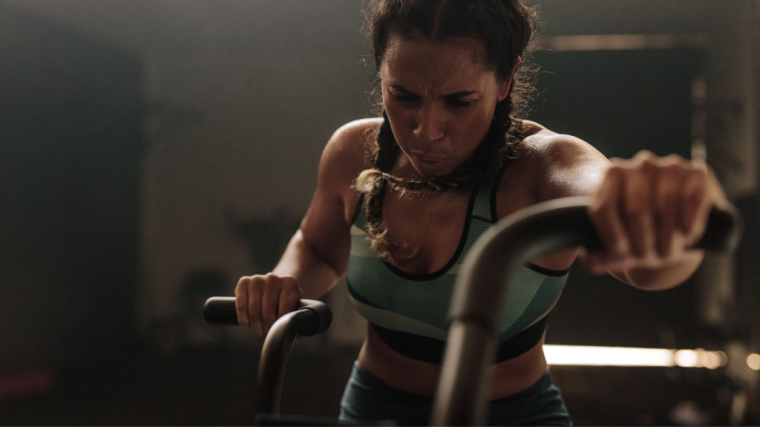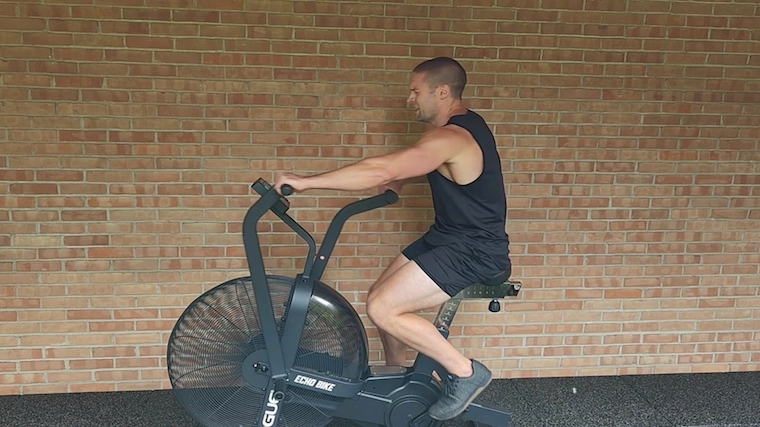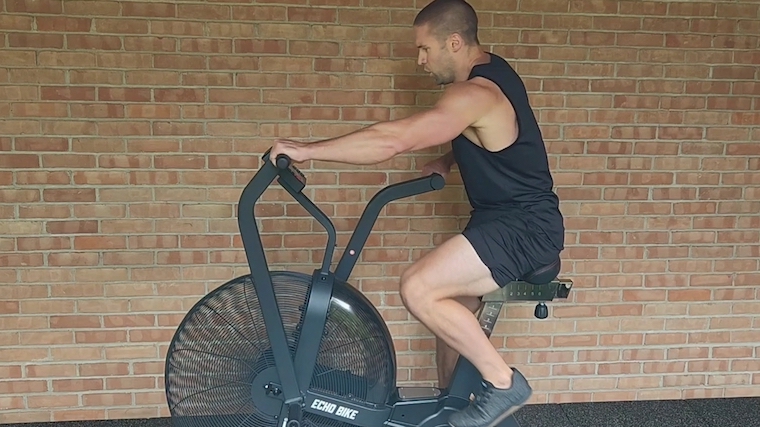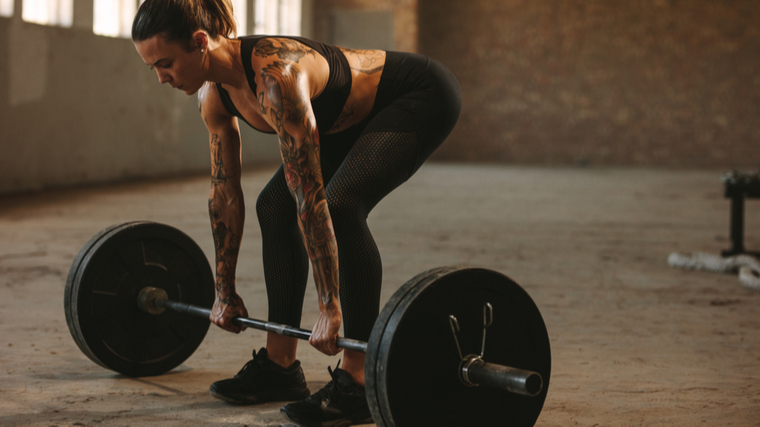Originally Posted At: https://breakingmuscle.com/feed/rss
Modern air bikes are far from the creaky machines your parents had at the local Y decades ago. Today’s machines are overbuilt and imposing. With bigger fans, heavier components, and electronic performance monitors, these machines are designed to take, and deliver, a beating.

The Assault Bike® is one of a handful of modern fan-resistance, full-body stationary bikes, or “air bikes.” Similar machines include the Echo Bike, Airdyne Pro, and various other models. However, much like Rollerblade®, Q-tip®, or Band-Aid®, “Assault bike” has become known universally to encompass all brands of air bikes, or simply as a phrase used interchangeably with “air bike.”
Because air bikes work muscle groups in the arms and legs simultaneously and without reprieve, they may be the most efficient machine for conditioning, shedding unwanted bodyweight, and training all major metabolic energy pathways.
If you’re lucky enough to have access to an air bike, check out the brutal workouts below.
Best Air Bike Workouts
Best Air Bike Workout for Conditioning
Due to their formidable and non-adjustable resistance, air bikes are thought to be more strength-based than spin bikes. (1) On a spin bike, individuals typically pedal at 70 to 110 revolutions per minute, whereas most riders on an air bike will reach 40 to 80 revolutions per minute. (1)
Unlike a spin bike, an air bike’s resistance progressively increases the harder and faster you ride. Altogether, air bikes may represent a preferable conditioning method for athletes with strength backgrounds and biases.
Air bikes also offer a more efficient method for training anaerobic capacity, or short-term, high-intensity endurance. Push hard enough on an air bike and you will lean hard into anaerobic glycolysis — a system that provides energy when demand outpaces our ability to deliver oxygen to the working muscles.

You’ll also experience the physical anguish associated with anaerobic training. Lactate is a metabolic by-product of anaerobic glycolysis. Workouts that produce uncomfortably high levels of lactate tend to be perceived as “hard workouts.” (2)
Compared to Wingate cycling — the gold standard “all-out” test of anaerobic fitness — a max effort ride of equal duration on an air bike produces higher lactate levels. Moreover, these elevated lactate levels diminish more slowly. (3)
Now, lactate is not the direct cause of muscle “burning”. Rather, lactate is produced alongside hydrogen ions, which alters the pH of your tissues, likely creating the searing burn of high-intensity exercise. (4) Have trust in the pain. This suffering pays dividends in the form of improved conditioning and fitness.
Modified Sprint Time-Trial Interval Training
Unless you’re a special type of masochist, you’re riding the air bike for the physiological benefits — the multi-system adaptations that improve our health and our ability to do more work inside and outside the gym.
Your go-to conditioning workout should be like a Swiss Army Knife — versatile yet manageable enough for practical use. Specifically, a robust conditioning workout should train all major energy systems (phosphocreatine, anaerobic glycolysis, and aerobic metabolism). A proper routine will also promote fatigue-resistance, tap into muscle fibers with massive potential for adaptation, and enhance your overall work capacity.
This air bike workout was inspired by a protocol developed by researchers out of Denmark. The original protocol consisted of six five-minute intervals at 85% of one’s maximum heart rate followed by two five-minute intervals with five 15-second all-out sprints followed by 45 seconds of active recovery. (5)
Only elite cyclists and triathletes were included in the Danish study, and the protocol made these extremely fit individuals fitter. For average folks, following an identical protocol would be insurmountable. Therefore, the volume and frequency of the program are modified.
Build towards the full, eight-interval protocol by adding one five-minute interval every month of consistent training. Repeat this workout once or twice per week, ideally after your resistance training or separated by at least six hours to avoid potential interference.
- How to Do it: Use your arms and legs to pedal during the high intensity intervals. You can use legs-only during the recovery periods. Warm-up thoroughly, and then perform three five-minute intervals at the fastest pace you can sustain for the duration, with two minutes rest or recovery between each interval. After the third recovery period, proceed into five shorter intervals with 15 seconds of an all-out sprint followed by 45 seconds of easy recovery pedaling.
- Sets and Reps: Three sets of five minutes moderate with two minutes recovery, followed by five sets of 15 seconds maximum effort with 45 seconds recovery.
- Rest time: Rest two minutes between each five-minute interval. Rest 45 seconds between each 15-second interval.
Best Air Bike Workout for Fat Loss
Air bikes may be the most “recoverable” form of cardio. The training stress is distributed across both the upper and lower body rather than overworking one area for the duration of the session.

Air bikes are also a ‘concentric-only’ exercise — meaning the involved muscle groups must overcome resistance with negligible eccentric, or “braking,” action. This makes them less likely to cause post-workout soreness.
High-load and/or high-volume eccentric exercise is associated with delayed onset muscle soreness (DOMS) and varying degrees of damage to the muscle cell at the microscopic level. (6) Ultimately, you’re less likely to be sore in the hours and days following a hard Assault bike workout compared to an eccentric-heavy mode of cardio (like jogging or jumping rope). As a bonus, concentric contractions are more energy demanding, which may result in greater energy expenditure during your workout.
Zone 2 Fat-Burning Workout
For a low-impact, total-body workout that is unlikely to leave you sore, you can’t beat Zone 2 cardio on an air bike. Zone 2 refers to low-to-moderate intensity aerobic exercise — 60 to 70% of your maximum heart-rate.
To find this range, first estimate your maximum heart rate as 220 minus your age (in years). Then, multiply that maximum heart rate by 0.6 and 0.7 to identify the upper and lower bounds of the training range.
If you’re not using a heart rate monitor, these numbers aren’t relevant and you can simply ride at the highest effort you can sustain while breathing only through your nose. If you break into open-mouth panting, you’re training too hard.
Aerobic training is driven by the breakdown of fats in the presence of oxygen. Non-endurance athletes benefit from aerobic training to improve body composition (e.g. fat loss), boost heart health, and enhance recovery between sets of resistance training.

Aerobically trained muscles develop better vascularization and greater density of mitochondria over time. These adaptations help our muscles to do more work and potentially recover more quickly.
The air bike is ideal for aerobic training, because it trains large muscle groups in the upper and lower body. Unless you enjoy the monotony of a steady-state workout, break your Zone 2 work into segments to stay motivated. This fat loss workout consists of five segments with descending calorie targets — use the readout on the bike’s display to monitor progress.
As part of a fat loss plan, repeat this workout three to five times per week, ideally after your resistance training or separated by at least six hours to avoid potential interference with recovery and performance.
- How to Do it: Warm up, and then begin the workout pedaling with your arms and legs together. Instead of tracking time, pedal to burn 120 calories, 110 calories, 100 calories, 90 calories, and then 80 calories. The goal is to achieve “negative splits” by completing each calorie-segment slightly faster than the previous. Be sure to maintain Zone 2 intensity throughout the workout, either by using a heart rate monitor or by maintaining nose-only breathing.
- Sets and Reps: Five calorie-segments: 120 calories, 110 calories, 100 calories, 90 calories, and 80 calories.
- Rest time: Rest passively (“following” the momentum of the pedals and handles) or actively (very low-intensity pedaling) for 30 seconds after reaching each calorie target. It should be just enough time to grab a sip of water or towel off before going again.
Best Air Bike Workout Finisher
A “finisher” refers to a short metabolic conditioning workout added to the end of your primary workout. After hitting the weights, for example, hop on the air bike to empty the tank and ensure you’ve gotten the most out of your workout.
Since you’ve already trained, your levels of muscle glycogen (a form of stored and readily accessible energy) will likely be low. “Training low,” or training with low levels of glycogen, stimulates energy system adaptations. (2) With regular high intensity interval training, your muscles will build larger stores of accessible energy and better manage the metabolic byproducts of high intensity training.
Sprint Interval Training
Consider this sprint interval training (SIT) “finisher” to rev your metabolism and leave you feeling accomplished when you leave the gym. The workout allows incomplete recovery between short, high-intensity bouts of riding.
Because “fast energy” from the phosphagen system doesn’t fully replenish between bouts, anaerobic glycolysis and aerobic pathways will contribute progressively to the energy demands of the workout. (7)
Translation: You’ll train all three major energy pathways in this workout. Perform this workout at the end of one resistance training workout each week.
- How to Do it: Because your weight training will have just ended, you should still be relatively warm. Perform just two minutes of easy pedaling and then begin the workout. Pedal with all-out effort, using arms and legs, for 20 seconds, every minute on the minute (EMOM). End with two minutes of easy pedaling.
- Sets and Reps: Perform intervals every minute on the minute for five minutes total.
- Rest time: Using the EMOM approach, work for 20 seconds and rest for the remaining 40 seconds of each minute. The rest period can be active (low-intensity pedaling) or passive (following the moving handles and pedals).
How to Warm-Up for Air Bike Workouts
A proper warm-up primes the body for movement and peak performance. Body temperature and blood flow increase, boosting metabolism and oxygen delivery to the working muscles.
Joints begin moving more freely. You might start to sweat, which helps with temperature regulation when the real work starts. Give this warm-up a try before your next air bike workout.
Air Bike Workout Warm-Up
- Easy ride: Spend three minutes pedaling at a low level of effort.
- Trunk rotations: Stay seated and brace your feet on the pegs. Maintain an upright posture as you rotate your trunk and reach forward with one arm. Alternate arms with each rotation. Perform 20 total repetitions, 10 per side.
- Legs-only ride: Rest your arms at your sides and ride for one minute at an “easy” effort using just your legs.
- Arms-only ride: Place your feet on the pegs and ride for one minute at an “easy” effort using just your arms.
- Triple ramp-up: Pedal with your arms and legs together for 10 seconds at an “easy” effort. Increase to a “moderate” effort for 10 seconds. Transition to a “hard” effort for 10 seconds. Perform the entire sequence a total of three times (90 seconds).
The Most Effective Cardio Machine?
The air bike is unrelenting and versatile. You can push as hard as you’re able during interval training or you can ease off for steady-state aerobic work. Air bike workouts are great for metabolic conditioning and fat loss. They can be stand-alone conditioning or fat loss sessions, or you can tack them onto the end of a traditional workout for a sprint interval “finisher.” Once your recovery and adaptation take their course, air bike workouts set you up for better fitness and future gains.
But you’ve been warned — they can be brutal.
References
- Schlegel, P., Křehký, A., Hiblbauer, J., & Faltys, V. (2022). Air biking as a new way for stress testing. Movement & Sport Sciences-Science & Motricité. Published online ahead of print. doi.org/10.1051/sm/2022001.
- Buchheit, M., & Laursen, P. B. (2013). High-intensity interval training, solutions to the programming puzzle. Sports Medicine, 43(5), 313-338.
- Schlegel, P., & Křehký, A. (2020). Anaerobic Fitness Testing in Crossfit. Acta Facultatis Educationis Physicae Universitatis Comenianae, 60(2), 217–228.
- Robergs, R. A., et al. (2018). Lactate, not lactic acid, is produced by cellular cytosolic energy catabolism. Physiology, 33(1), 10-12.
- Gejl, K. D., Andersson, E. P., Nielsen, J., Holmberg, H. C., & Ørtenblad, N. (2020). Effects of acute exercise and training on the sarcoplasmic reticulum Ca2+ release and uptake rates in highly trained endurance athletes. Frontiers in Physiology, 11, 810.
- Hotfiel, T., et al. (2018). Advances in delayed-onset muscle soreness (DOMS): Part I: Pathogenesis and diagnostics. Sportverletzung· Sportschaden, 32(04), 243-250.
- Bogdanis, G. C., Nevill, M. E., Boobis, L. H., & Lakomy, H. K. (1996). Contribution of phosphocreatine and aerobic metabolism to energy supply during repeated sprint exercise. Journal of Applied Physiology, 80(3), 876–884.
Featured Image: Boonkung / Shutterstock
The post Try These 3 Air Bike Workouts for Conditioning, Fat Loss, and More appeared first on Breaking Muscle.

 You’ve probably seen a BOSU exercise ball at the gym. It’s that piece of equipment hanging out by the free weights that looks like half of an inflated beach ball about two feet in diameter attached to a flat disc. You know the one. But do you know what to do with it? Have you ever incorporated a BOSU ball into your workout?
You’ve probably seen a BOSU exercise ball at the gym. It’s that piece of equipment hanging out by the free weights that looks like half of an inflated beach ball about two feet in diameter attached to a flat disc. You know the one. But do you know what to do with it? Have you ever incorporated a BOSU ball into your workout?











 Looking for a warm and cozy meal? Our beef stew is the perfect meal to cook for a dinner spent inside. Filled with plenty of vegetables, such as radishes and carrots this stew can be cooked on the stovetop or in the oven for ease. Not only is this Keto Beef Stew great on its own, you can easily top it on cauliflower rice or mash.
Looking for a warm and cozy meal? Our beef stew is the perfect meal to cook for a dinner spent inside. Filled with plenty of vegetables, such as radishes and carrots this stew can be cooked on the stovetop or in the oven for ease. Not only is this Keto Beef Stew great on its own, you can easily top it on cauliflower rice or mash.




 For now classes are 6pm and 640pm at 2840 Wildwood st in the Boise Cloggers studio.
Book your class NOW!
click this ==>
For now classes are 6pm and 640pm at 2840 Wildwood st in the Boise Cloggers studio.
Book your class NOW!
click this ==>








